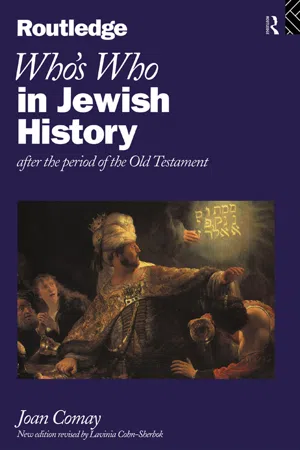
eBook - ePub
Who's Who in Jewish History
After the period of the Old Testament
This is a test
- 448 pages
- English
- ePUB (mobile friendly)
- Available on iOS & Android
eBook - ePub
Who's Who in Jewish History
After the period of the Old Testament
Book details
Book preview
Table of contents
Citations
About This Book
From Karl Marx to the Marx brothers, the Routledge Who's Who in Jewish History presents a complete and thoroughly updated reference guide to over a thousand prominent men and women who have shaped Jewish culture. Covering twenty centuries of Jewish history it provides:
* detailed biographical information on each leading figure
* analysis of their role and significance both in Jewish life and the wider culture
* a comprehensive chronological table displaying the history of the Jewish race
* a series of maps
* a useful glossary giving precise definitions of Jewish words.
Frequently asked questions
At the moment all of our mobile-responsive ePub books are available to download via the app. Most of our PDFs are also available to download and we're working on making the final remaining ones downloadable now. Learn more here.
Both plans give you full access to the library and all of Perlego’s features. The only differences are the price and subscription period: With the annual plan you’ll save around 30% compared to 12 months on the monthly plan.
We are an online textbook subscription service, where you can get access to an entire online library for less than the price of a single book per month. With over 1 million books across 1000+ topics, we’ve got you covered! Learn more here.
Look out for the read-aloud symbol on your next book to see if you can listen to it. The read-aloud tool reads text aloud for you, highlighting the text as it is being read. You can pause it, speed it up and slow it down. Learn more here.
Yes, you can access Who's Who in Jewish History by New edition revised by Lavinia Cohn-Sherbok, Joan Comay in PDF and/or ePUB format, as well as other popular books in Theology & Religion & Religion. We have over one million books available in our catalogue for you to explore.
Information
Z
ZACH, Nathan b. 1930. Israeli writer. Zach emigrated to Palestine in 1930. He was educated at the Hebrew University and has taught at Essex University in England and Haifa University. He is best known for his poetry and he is regarded as one of the central figures in Israeli literature. He insists on the poet’s freedom from all externally imposed ideology and he has attacked Natan ALTERMAN for his adherence to the norms of European symbolism. A selection of his poetry has been translated into English as The Static Element (1982).
ZACUTO, Abraham ben-Samuel 1452–c. 1515. Astronomer and historian. Zacuto was a professor at the university in his home town of Salamanca and then in Saragossa. He wrote his first work on astronomy (1473–8) for the bishop of Salamanca. It was written in Hebrew and translated into Spanish and Latin. His astronomical tables, vital tools for navigators, were used by COLUMBUS. On the expulsion of the Jews from Spain in 1492, Zacuto was appointed court astronomer to King John II of Portugal, serving his successor Manuel I in the same capacity. His advice was sought before Vasco da Gama’s expedition to the New World and Da Gama’s ships carried Zacuto’s metal astrolabe, the first of its kind. When Manuel I determined to convert the Jews of Portugal by force, Zacuto fled in 1497, and after a hazardous journey reached Tunis. There in 1504 he wrote his genealogical history of the Jews from the creation until 1500. While unhistorical by modern standards, the work is of great literary importance.
ZADKINE, Ossip 1890–1967. Sculptor. The work of Russian-born Ossip Zadkine was influenced by primitive art and later in Paris by the cubist movement. His greatest work, The Destroyed City, stands in Rotterdam. It shows an agonized woman with outstretched arms warding off falling bombs, and symbolizing the ruthless aerial attack on the city by the Nazis in 1940.
ZAMENHOF, Ludwik Lazar 1859–1917. Polish inventor of Esperanto. Zamenhof was a Polish eye specialist, and the son of a language teacher. After years of research, he published in 1887 a handbook for Esperanto, a synthetic international language with a simplified vocabulary and grammar. In 1905 he convened in Paris the first of a number of international conferences in support of the language.
ZANGWILL, Israel 1864–1926. British author and founder of the Jewish Territorial Organization. In the two decades from 1880 to 1900, the influx of immigrants from Russia swelled the Jewish population of London from 45,000 to 150,000, mostly concentrated in the East End in conditions of poverty and overcrowding. They found a chronicler of the first rank in Israel Zangwill, the London-born son of Russian immigrant pa...
Table of contents
- Cover Page
- Who’s Who Series
- Title Page
- Copyright Page
- List of Maps
- Author’s Preface
- Glossary
- Chronology
- A
- B
- C
- D
- E
- F
- G
- H
- I
- J
- K
- L
- M
- N
- O
- P
- R
- S
- T
- UV
- W
- Y
- Z